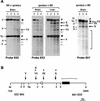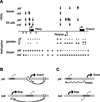Epigenetic properties and identification of an imprint mark in the Nesp-Gnasxl domain of the mouse Gnas imprinted locus
- PMID: 12897124
- PMCID: PMC166348
- DOI: 10.1128/MCB.23.16.5475-5488.2003
Epigenetic properties and identification of an imprint mark in the Nesp-Gnasxl domain of the mouse Gnas imprinted locus
Abstract
The Gnas locus in the mouse is imprinted with a complex arrangement of alternative transcripts defined by promoters with different patterns of monoallelic expression. The Gnas transcript is subject to tissue-specific imprinted expression, Nesp is expressed only from the maternal allele, and Gnasxl is expressed only from the paternal allele. The mechanisms controlling these expression patterns are not known. To identify potential imprinting regulatory regions, particularly for the reciprocally expressed Nesp and Gnasxl promoters, we examined epigenetic properties of the locus in gametes, embryonic stem cells, and fetal and adult tissues. The Nesp and Gnasxl promoter regions are contained in extensive CpG islands with methylation of the paternal allele at Nesp and the maternal allele at Gnasxl. Parental allele-specific DNase I-hypersensitive sites were found at these regions, which correlate with hypomethylation rather than actual expression status. A germ line methylation mark was identified covering the promoters for Gnasxl and the antisense transcript Nespas. Prominent DNase I-hypersensitive sites present on paternal alleles in embryonic stem cells are contained within this mark. This is the second gametic mark identified at Gnas and suggests that the Nesp and Gnasxl promoters are under separate control from the Gnas promoter. We propose models to account for the regulation of imprinting at the locus.
Figures







Similar articles
-
An imprinted transcript, antisense to Nesp, adds complexity to the cluster of imprinted genes at the mouse Gnas locus.Proc Natl Acad Sci U S A. 2000 Mar 28;97(7):3342-6. doi: 10.1073/pnas.97.7.3342. Proc Natl Acad Sci U S A. 2000. PMID: 10716699 Free PMC article.
-
Alternative non-coding splice variants of Nespas, an imprinted gene antisense to Nesp in the Gnas imprinting cluster.Mamm Genome. 2002 Feb;13(2):74-9. doi: 10.1007/s00335-001-2102-2. Mamm Genome. 2002. PMID: 11889554
-
Transcription driven somatic DNA methylation within the imprinted Gnas cluster.PLoS One. 2015 Feb 6;10(2):e0117378. doi: 10.1371/journal.pone.0117378. eCollection 2015. PLoS One. 2015. PMID: 25659103 Free PMC article.
-
Control of imprinting at the Gnas cluster.Epigenetics. 2007 Oct-Dec;2(4):207-13. doi: 10.4161/epi.2.4.5380. Epub 2007 Dec 5. Epigenetics. 2007. PMID: 18094621 Review.
-
Imprinting on chromosome 20: tissue-specific imprinting and imprinting mutations in the GNAS locus.Am J Med Genet C Semin Med Genet. 2010 Aug 15;154C(3):377-86. doi: 10.1002/ajmg.c.30271. Am J Med Genet C Semin Med Genet. 2010. PMID: 20803660 Review.
Cited by
-
The evolution of mammalian genomic imprinting was accompanied by the acquisition of novel CpG islands.Genome Biol Evol. 2011;3:1276-83. doi: 10.1093/gbe/evr104. Epub 2011 Oct 19. Genome Biol Evol. 2011. PMID: 22016334 Free PMC article.
-
Establishing Chromatin Regulatory Landscape during Mouse Preimplantation Development.Cell. 2016 Jun 2;165(6):1375-1388. doi: 10.1016/j.cell.2016.05.050. Cell. 2016. PMID: 27259149 Free PMC article.
-
Duplication of 17q11.2 and Features of Albright Hereditary Osteodystrophy Secondary to Methylation Defects within the GNAS Cluster: Coincidence or Causal?Case Rep Genet. 2013;2013:764152. doi: 10.1155/2013/764152. Epub 2013 Jan 14. Case Rep Genet. 2013. PMID: 23424688 Free PMC article.
-
Hemimethylation of CpG dyads is characteristic of secondary DMRs associated with imprinted loci and correlates with 5-hydroxymethylcytosine at paternally methylated sequences.Epigenetics Chromatin. 2019 Oct 17;12(1):64. doi: 10.1186/s13072-019-0309-2. Epigenetics Chromatin. 2019. PMID: 31623686 Free PMC article.
-
Autonomous silencing of the imprinted Cdkn1c gene in stem cells.Epigenetics. 2010 Apr;5(3):214-21. doi: 10.4161/epi.5.3.11275. Epub 2010 Apr 1. Epigenetics. 2010. PMID: 20372090 Free PMC article.
References
-
- Arnaud, P., D. Monk, M. Hitchins, E. Gordon, W. Dean, C. V. Beechey, J. Peters, W. Craigen, M. Preece, P. Stanier, G. E. Moore, G. E., and G. Kelsey. 2003. Conserved methylation imprints in the human and mouse GRB10 genes with divergent allelic expression suggests differential reading of the same mark. Hum. Mol. Genet. 12:1005-1019. - PubMed
-
- Ball, S. T., C. M. Williamson, C. Hayes, T. Hacker, and J. Peters. 2001. The spatial and temporal expression pattern of Nesp and its antisense Nespas, in mid-gestation mouse embryos. Mech. Dev. 100:79-81. - PubMed
-
- Bastepe, M., J. E. Pincus, T. Sugimoto, K. Tojo, M. Kanatani, Y. Azuma, K. Kruse, A. L. Rosenbloom, H. Koshiyama, and H. Jüppner. 2001. Positional dissociation between the genetic mutation responsible for pseudohypoparathyroidism type 1b and the associated methylation defect at exon A/B: evidence for a long-range regulatory element within the imprinted GNAS1 locus. Hum. Mol. Genet. 10:1231-1241. - PubMed
-
- Bell, A. C., and G. Felsenfeld. 2000. Methylation of a CTCF-dependent boundary controls imprinted expression of the Igf2 gene. Nature 405:482-485. - PubMed
MeSH terms
Substances
LinkOut - more resources
Full Text Sources
Other Literature Sources
